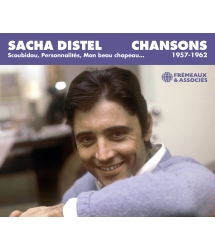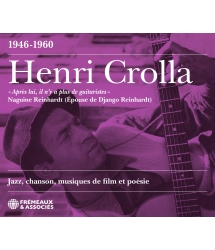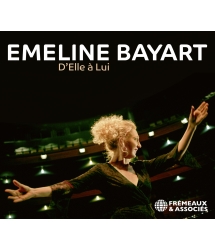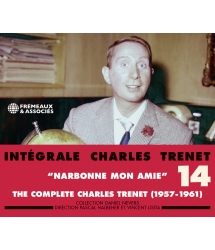- Our Catalog
- Philosophy
- Philosophers of the 20th century and today
- History of Philosophy (PUF)
- Counter-History and Brief Encyclopedia by Michel Onfray
- The philosophical work explained by Luc Ferry
- Ancient thought
- Thinkers of yesterday as seen by the philosophers of today
- Historical philosophical texts interpreted by great actors
- History
- Books (in French)
- Social science
- Historical words
- Audiobooks & Literature
- Our Catalog
- Jazz
- Blues
- Rock - Country - Cajun
- French song
- World music
- Africa
- France
- Québec / Canada
- Hawaï
- West Indies
- Caribbean
- Cuba & Afro-cubain
- Mexico
- South America
- Tango
- Brazil
- Tzigane / Gypsy
- Fado / Portugal
- Flamenco / Spain
- Yiddish / Israel
- China
- Tibet / Nepal
- Asia
- Indian Ocean / Madagascar
- Japan
- Indonesia
- Oceania
- India
- Bangladesh
- USSR / Communist songs
- World music / Miscellaneous
- Classical music
- Composers - Movie Soundtracks
- Sounds of nature
- Our Catalog
- Youth
- Philosophy
- News
- How to order ?
- Receive the catalog
- Manifesto
- Dictionnary











- Our Catalog
- Philosophy
- Philosophers of the 20th century and today
- History of Philosophy (PUF)
- Counter-History and Brief Encyclopedia by Michel Onfray
- The philosophical work explained by Luc Ferry
- Ancient thought
- Thinkers of yesterday as seen by the philosophers of today
- Historical philosophical texts interpreted by great actors
- History
- Books (in French)
- Social science
- Historical words
- Audiobooks & Literature
- Our Catalog
- Jazz
- Blues
- Rock - Country - Cajun
- French song
- World music
- Africa
- France
- Québec / Canada
- Hawaï
- West Indies
- Caribbean
- Cuba & Afro-cubain
- Mexico
- South America
- Tango
- Brazil
- Tzigane / Gypsy
- Fado / Portugal
- Flamenco / Spain
- Yiddish / Israel
- China
- Tibet / Nepal
- Asia
- Indian Ocean / Madagascar
- Japan
- Indonesia
- Oceania
- India
- Bangladesh
- USSR / Communist songs
- World music / Miscellaneous
- Classical music
- Composers - Movie Soundtracks
- Sounds of nature
- Our Catalog
- Youth
- Philosophy
- News
- How to order ?
- Receive the catalog
- Manifesto
- Dictionnary
THE WORLD FAMOUS CROONER 1931-1950
Jean Sablon
Ref.: FA5034
Artistic Direction : ALAIN BOULANGER
Label : Frémeaux & Associés
Total duration of the pack : 1 hours 54 minutes
Nbre. CD : 2
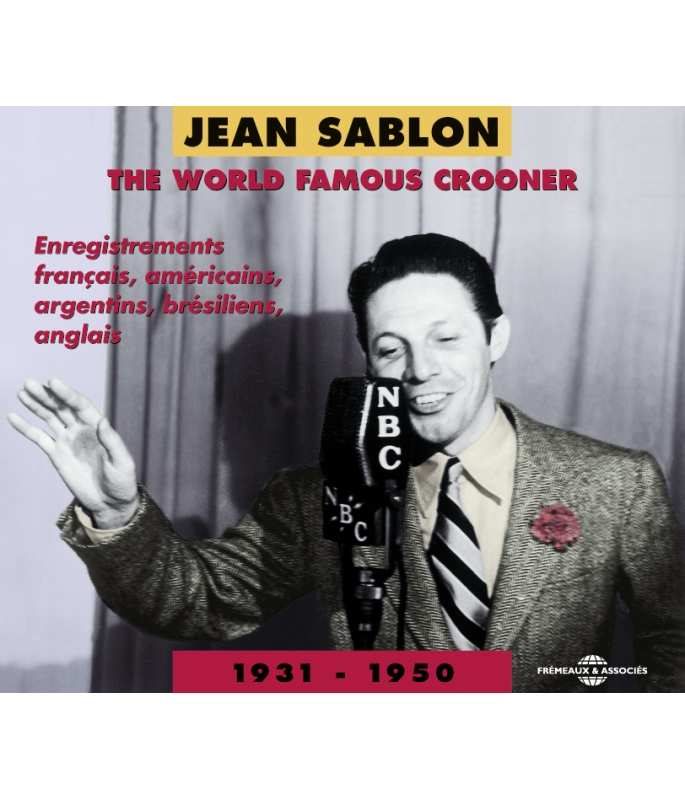
THE WORLD FAMOUS CROONER 1931-1950
- - RECOMMANDÉ PAR PHONOSCOPIES
THE WORLD FAMOUS CROONER 1931-1950
(2-CD set) From New York to Paris, from Los Angeles to Rio de Janeiro or from Montreal to Montevideo, Jean Sablon was more acclaimed than any other French singer. The numerous titles selected here, re-issued for the first time, prove that from 1930 to 1950 he was best ambassador of French song which, thanks to him, became known throughout the world. Includes a 24 page booklet with both French and English notes.

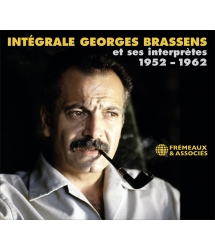
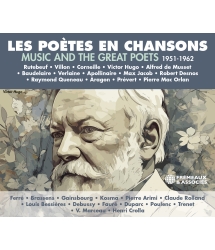
-
PisteTitleMain artistAutorDurationRegistered in
-
1PUISQUE VOUS PARTEZ EN VOYAGEMIREILLEMIREILLE00:03:181935
-
2CHE QUE MARAVILLAORCH TIPICA AJ PESENTISAB ANDRE00:02:381931
-
3BEGUIN BIGUINEJEAN SABLONMICHEL EMER00:02:471932
-
4AFRAID TO DREAMJEAN SABLONH REVEL00:03:271937
-
5CAN I FORGET YOUJEAN SABLONJEROME KERN00:03:161937
-
6LE FIACREJEAN SABLONLEON XANROFF00:02:371939
-
7RENDEZ VOUS TIME IN PAREEJEAN SABLONA L DUBIN00:03:081939
-
8SOUTH AMERICAN WAYJEAN SABLONA L DUBIN00:02:361939
-
9SILVER ON THE SAGEJEAN SABLONL RUBIN00:03:141939
-
10J ATTENDRAIJEAN SABLOND OLIVIERI00:02:431939
-
11UN VIOLON DANS LA NUITJEAN SABLONC A BIXIO00:02:471940
-
12EN SEPTEMBRE SOUS LA PLUIEJEAN SABLONHARRY WARREN00:02:441940
-
13LA MERE MICHELJEAN SABLONTRADITIONNEL00:03:011940
-
14BONSOIRJEAN SABLONJACQUES LARUE00:03:071940
-
15SERENADE (PORTUGAISE)JEAN SABLONCHARLES TRENET00:03:121942
-
16JEAN JEANJEAN SABLONTRADITIONNEL00:02:411942
-
17JE N EN CONNAIS PAS LA FINJEAN SABLONMARGUERITE MONNOT00:03:031942
-
18ELLE N EST PAS SI MAL QUE CAJEAN SABLONALBERT WILLEMETZ00:03:011942
-
19INSENSIBLEMENTJEAN SABLONPAUL MISRAKI00:03:241942
-
PisteTitleMain artistAutorDurationRegistered in
-
1C EST LA PREMIERE FOISJEAN SABLONPAUL MISRAKI00:03:041942
-
2RENDEZ VOUS SOUS LA PLUIEJEAN SABLONCHARLES TRENET00:02:531942
-
3SYMPHONYJEAN SABLONALEX ALSTONE00:03:191945
-
4PORQUEJEAN SABLONCAYMMI DORIVAL00:02:441946
-
5LA CHANSON DES RUESJEAN SABLONR GOEHR00:03:161946
-
6PASSEJEAN SABLONJEAN SABLON00:03:211946
-
7THESE FOOLISH THINGSJEAN SABLONJ STRACHEY00:03:121946
-
8I WONDER WHO S KISSING HER NOWJEAN SABLONHOUGHS00:02:381947
-
9ROSES IN THE RAINJEAN SABLONFRISCH00:03:281947
-
10LILETTEJEAN SABLONJ GOLD00:02:491947
-
11TELL ME MARIANNEJEAN SABLONE DONATO00:02:171947
-
12I LL STOP LOVING YOUJEAN SABLONTAYLOR00:03:011948
-
13SON VOILE QUI VOLAITJEAN SABLONTRADITIONNEL00:02:501948
-
14DITES MOIJEAN SABLONOSCAR HAMMERSTEIN II00:03:061949
-
15PARIS WAKES UP AND SMILESJEAN SABLONIRVING BERLIN00:03:071949
-
16LA VIE EN ROSEJEAN SABLONEDITH PIAF00:03:091950
-
17MALADIE D AMOURJEAN SABLONTRADITIONNEL00:03:031950
-
18CLOPIN CLOPANTJEAN SABLONBRUNO COQUATRIX00:02:591950
-
19MY FOOLISH HEARTJEAN SABLONWASHINGTON00:03:251950
Jean Sablon The World famous crooner FA5034
JEAN SABLON
The world famous crooner
Enregistrements français, américains, argentins, brésiliens, anglais
1931-1950
DISCOGRAPHY
Disque 1
1 - PUISQUE VOUS PARTEZ EN VOYAGE - Jean SABLON et MIREILLE
(Mireille - Jean Nohain) Columbia DF 1846 (CL 5526-1) Paris, 12.12.1935
2 - CHE QUE MARAVILLA - Orquestra Tipica A.J. Pesenti - Refrain Jean Sablon
(André Sab - L. Sevestre - M. Cab - H. Varna) Columbia DF 466 (L 2898-1)
Paris, mars 1931
3 - BÉGUIN-BIGUINE - Don BARRETO et son orchestre cubain du Melody’s - Refrain Jean Sablon (M. Emer - Jamblan) Columbia DF 878 (L 3690-1)
Paris, 3 mai1932
4 - AFRAID TO DREAM (du film You can’t have everything)
accompagné par l’orchestre de Norman CLOUTIER
(M. Gordon - H. Revel) Victor 25463 (BS 011656-1) New York, 5 août 1937
5 - CAN I FORGET YOU (du film High, wide and handsome)
accompagné par l’orchestre de Norman CLOUTIER
(O. Hammerstein - J. Kern) Victor 25463 (BS 011654-1) New York, 5 août 1937
6 - LE FIACRE accompagné par WAL-BERG et son orchestre
(Xanroff) Victor (Arg.) 26927 (OLA 3009) prise 2 - Paris, 25 mars 1939
7 - RENDEZ-VOUS TIME IN PAREE (de la comédie musicale Streets of Paris)
accompagné par l’orchestre de Leonard JOY
(A. Dubin - J. McHugh) Victor 26269 (BS 037148-1) New York, 24 mai 1939
8 - SOUTH AMERICAN WAY (de la comédie musicale Streets of Paris)
accompagné par l’orchestre de Leonard JOY
(A. Dubin - J. McHugh) Victor (Brésil) 45961 (BS 037151-1) New York, 24 mai 1939
9 - SILVER ON THE SAGE (la chanson du cow boy) (du film Héroïne du Texas)
accompagné par l’orchestre CASINO ATLANTICO, dir. F. FERREIRA FILHO
(L. Rubin - R. Rainger) Victor (Brésil) 45964 (33162) Rio de Janeiro, 28 sept. 1939
10 - J’ATTENDRAI accompagné par l’orchestre CASINO ATLANTICO,
dir. F. FERREIRA FILHO
(D. Olivieri - L. Poterat) Victor (Brésil) 45964 (33163) Rio de Janeiro, 28 sept. 1939
11 - UN VIOLON DANS LA NUIT accompagnement guitare et piano
(C.A. Bixio - B. Cherubini) Victor (Brésil) 45995 (33419) Rio de Janeiro, 5 mai 1940
12 - EN SEPTEMBRE SOUS LA PLUIE accompagnement guitare et piano
(J. Larue - H. Warren) Victor (Brésil) 45995 (33418) Rio de Janeiro, 5 mai 1940
13 - LA MÈRE MICHEL accompagné par l’orchestre HAMILTON-VARELA
(Folklore - arrangement J. Sablon) Victor (Arg.) 39076 Buenos Aires, août 1940
14 - BONSOIR accompagné par l’orchestre HAMILTON-VARELA
(J. Larue - J. Sablon - A. Siniavine) Victor (Arg.) 39076 Buenos Aires, août 1940
15 - SÉRÉNADE (sérénade portugaise) accompagné par l’orchestre de Paul BARON
(Charles Trénet) Decca 23257 (70789-A) New York, 28 mai 1942
16 - JEAN - JEAN accompagné par l’orchestre de Paul BARON
(Folklore) Decca 23255 (70829-A) New York, 8 juin 1942
17 - JE N’EN CONNAIS PAS LA FIN accompagné par l’orchestre de Paul BARON
(M. Monnot - R. Asso) Decca 23257 (70830-A) New York, 8 juin 1942
18 - ELLE N’EST PAS SI MAL QUE çA accompagné par l’orchestre de Paul BARON
(H. Christiné - Willemetz) Decca 23256 (70831-B) New York, 8 juin 1942
19 - INSENSIBLEMENT accompagné par l’orchestre DAJOS BELA
(P. Misraki - arrangement A. Galiana) Odéon (Arg.) 286080 (C-12431)
Buenos Aires, nov./déc. 1942
Disque 2
1 - C’EST LA PREMIÈRE FOIS accompagné par l’orchestre DAJOS BELA
(P. Misraki) Odéon (Arg.) 286080 (C12432) Buenos-Aires, nov./déc. 1942
2 - RENDEZ-VOUS SOUS LA PLUIE accompagné par l’orchestre DAJOS BELA
(C. Trénet - J. Hess - arrangement A. Galiana) Odéon (Arg.) 286081 (C12433)
Buenos-Aires, nov./déc. 1942
3 - SYMPHONY accompagné par l’orchestre Paul BARON
(Alstone-Tabet-Bernstein-Lawrence) Decca 40002 (73252-A) New York, 18 déc. 1945
4 - PORQUE accompagné par l’orchestre Paul BARON
(Dorival Caymmi - C. Sigman) Decca 40021 (73391-A) New York, 25 février 1946
5 - LA CHANSON DES RUES accompagné par l’orchestre Paul BARON
(R. Goehr - M. Vaucaire - A. Stillman) Decca 40005 (73394-A) New York, 25 février 1946
6 - PASSÉ accompagné par l’orchestre Irving ROSS
(E. Delange - C. Sigman - J. Meyer - J. Sablon - J. Geiringer) Decca 40009 (73492-A)
New York, 1er avril 1946
7 - THESE FOOLISH THINGS (Remind me of you)
accompagné par l’orchestre Irving ROSS
(J. Strachey - H. Marvell - H. Linck) Decca 40009 (73493-A) New York, 1er avril 1946
8 - I WONDER WHO’S KISSING HER NOW
accompagné par l’orchestre de Toots CAMARATA
(Houghs - Adams - Howard) RCA Victor 250101 (D7.VB 503-1) New York, 22 avril 1947
9 - ROSES IN THE RAIN accompagné par l’orchestre de Toots CAMARATA
(Frisch - Wise - Carle) RCA Victor 250094 New York, 22 avril 1947
10 - LILETTE accompagné par l’orchestre de Toots CAMARATA
(J. Gold) RCA Victor 203111 (D7-VB 2754-1) New York, 2 décembre 1947
11 - TELL ME MARIANNE (A media luz)
accompagné par l’orchestre de Toots CAMARATA
(E. Donato - Musel - Kaye) RCA Victor 233111 (D7-VB 2757-1) New York, 2 déc. 1947
12 - I’LL STOP LOVING YOU accompagné par l’orchestre Philip GREEN
(Taylor - Car) RCA Victor (Brésil) 825308 (OEA 12848-1) Londres, 27 mars 1948
13 - SON VOILE QUI VOLAIT accompagné par l’orchestre Philip GREEN
(Folklore) RCA Victor (Brésil) 825308 (OEA 12849-1) Londres, 27 mars 1948
14 - DITES-MOI (Tell me why) (de la revue South Pacific)
accompagné par Ellis LARKIN Trio et Quartette vocal
(O. Hammerstein - R. Rodgers) RCA Victor 20-3473 (D9 VB-1443-1) New York, été 1949
15 - PARIS WAKES UP AND SMILES (de la revue Miss Liberty)
accompagné par Ellis LARKIN Trio et Quartette vocal
(I. Berlin) RCA Victor 20-3473 (D9 VB-1444-1) New York, été 1949
16 - LA VIE EN ROSE accompagné par l’orchestre VIERI-FIDANZINI
(C. Louiguy - E. Piaf) RCA Victor (Arg.) 680040 Buenos Aires, 1950
17 - MALADIE D’AMOUR accompagné par l’orchestre VIERI-FIDANZINI
(Folklore antillais) RCA Victor (Arg.) 680040 Buenos Aires, 1950
18 - CLOPIN-CLOPANT accompagné par l’orchestre VIERI-FIDANZINI
(P. Dudan - B. Coquatrix) RCA Victor (Arg.) 680039 Buenos Aires, 1950
19 - MY FOOLISH HEART accompagné par l’orchestre Woolf PHILLIPS
(Washington - Young) H-M-V B-9914 (OEA 14555-1) Londres, 30 mars 1950
Et si nous partions en voyage, nous aussi, avec Jean Sablon! Serait-il possible de trouver meilleur guide que celui qui fut l’un des plus charmants ambassadeurs de la chanson française à travers le monde?
Bien peu nombreux sont les chanteurs français dont la renommée a dépassé le cadre de nos frontières, Maurice Chevalier, Mistinguett’, Lucienne Boyer... et plus près de nous Gilbert Becaud, Charles Trenet, Yves Montand; Charles Aznavour, Edith Piaf... nous ne devons pas, pensons-nous en oublier beaucoup. Aucun n’a eu un succès et une notoriété aussi durable dans toute l’Amérique, du Canada à la Terre de Feu, que Jean Sablon.
Notre propos dans ce livret n’est pas de retracer sa vie ni sa carrière. D’autres l’ont fait infiniment mieux que nous ne saurions le faire. Tout simplement nous nous promènerons, des Etats-Unis au Brésil, du Canada à l’Argentine, en compagnie de Jean Sablon, tout en écoutant quelques-uns des succès qu’il a enregistré loin de sa patrie, pour le plus grand rayonnement de la chanson française.
****
Né le 25 mars 1906, Jean Sablon a donc 22 ans depuis peu lorsqu’en juillet 1928 il effectue son premier voyage en Amérique latine, au Brésil plus précisément, au sein de la Troupe des Bouffes-Parisiens dont les principales vedettes sont Milton, Urban et Alice Cocéa, troupe qui avait été engagée pour l’inauguration de l’Hôtel Copacabana Palace qui venait d’être construit au bord de la célèbre plage carioca. Aucun enregistrement phonographique ne fut effectué au cours de cette tournée.
L’année suivante Sablon effectue un séjour en Martinique. Il y apprend des chansons en créole et fréquente ce qu’il appelle “le Bal Doudou”, vraisemblablement le “Select Tango”, le grand dancing de Fort-de-France qui avait ouvert ses portes en janvier 1921.
C’est en souvenir de ce voyage qu’il demandera quelques années plus tard à Jamblan et Michel Emer de lui écrire une chanson “Beguin-Biguine” qu’il enregistre le 3 mai 1932 en compagnie de l’orchestre cubain de l’excellent guitariste Don Barreto que nous écoutons sur ce C.D.
En mars 1931 la Revue Argentine menée par une troupe arrivée de Buenos Aires via Madrid, se produit au Palace, rue du Faubourg Montmartre. Sablon y chante et y danse en compagnie d’une des vedettes, Gloria Guzman : “Chè que maravilla”, composé par son frère André, sous le pseudonyme transparent d’André Sab. Il l’enregistre la même année sous la marque Columbia avec l’orchestre de A.J. Pesenti. Bien que “Que maravilla” soient les seuls mots en espagnol - en argentin plutôt - de la chanson, Sablon les prononce avec le plus pur accent “porteño”.
Toujours au Palace, en mai de la, même année, Jean Sablon est en compagnie de Carlos Gardel dans la revue d’Henri Varna “Parade de Femmes”. Il a l’occasion de parfaire encore son accent “porteño” en donnant des leçons de français à la grande vedette argentine - bien que née à Toulouse - Gardel ayant voulu pour plaire au public parisien, interpréter quelques chansons dans notre langue.
Deux ans plus tard, 1933, Sablon effectue un voyage, d’agrément celui-là, en compagnie de Mireille, sa partenaire de maintes chansons, aux Etats-Unis.
Les années suivantes, 1934 et 1935 verront Jean Sablon effectuer plusieurs séjours à Londres. Il se produit à la B.B.C. et commence ainsi à roder un tour de chant en anglais.
En 1936, engagé à Paris pour chanter dans une émission radiophonique, “Le Show Cadum” il est remarqué par un imprésario américain qui lui propose d’interpréter deux chansons, dont une en anglais pour une émission intercontinentale retransmise jusqu’à New York dans le programme “The Magic Key”. Le succès est immense, voici notre chanteur promu vedette internationale.
Quelques mois plus tard, début 1937, Sablon, un solide contrat de le chaîne de radio N.B.C. en poche embarque à bord du paquebot Ile de France pour les Etats-Unis.
Il est chaleureusement accueilli à New York et quelques jours plus tard commence des émissions bi-hebdomadaires, à une heure de grande écoute, pour la N.B.C. La radio était reine en ces années d’avant-guerre, la télévision n’était encore qu’un engin de laboratoire, une bonne émission radiophonique pouvait avoir des millions d’auditeurs. Celle de Jean Sablon connaît d’emblée un succès de la côte Est à la côte Ouest jusqu’où elle est diffusée. La mélodie “Vous qui passez sans me voir” par laquelle elle débute invariablement est bientôt sur toutes les lèvres. Sablon que l’on a surnommé “The French Troubadour” devient pour tous les américains le symbole du Latin-Lover qu’avait été avant lui Maurice Chevalier lors de ses tournages hollywoodiens.
Ce premier séjour professionnel de Jean Sablon en Amérique du Nord va durer presque deux ans. Il sillonne le continent d’est en ouest et du nord au sud, poussant jusqu’à Los Angeles et au Canada. Il enregistre pour R.C.A. Victor plusieurs disques en français et en anglais accompagné par l’orchestre de Norman Cloutier. Nous en rééditons ici quelques-uns.
Sablon, qui vient de se retremper dans l’air du pays, passant presque une année entière en France, année au cours de laquelle il se produit pendant un mois à l’A.B.C. à Paris, reprend au printemps 1939 le chemin des Etats-Unis.
Engagé par le producteur Lee Schubert pour être la vedette principale de la revue “Streets of Paris”, il rôde celle-ci à Boston durant un mois puis débute le 10 juin à Broadway. Il y a pour partenaires le duo comique (?) Abbott et Costello (connu en France sous le pseudonyme des “deux nigauds”) sorte de Laurel et Hardy au rabais et surtout l’extraordinaire vedette brésilienne, la femme aux chapeaux extravagants et aux talons démesurés : Carmen Miranda qui est accompagnée par un formidable orchestre “O Bando da Lua”. La revue remporte un succès considérable, Sablon et Carmen Miranda en obtenant chacun leur part. Sablon enregistre accompagné par la formation de Léonard Joy quelques-uns de ses succès dont : South American Way “à la manière sud-américaine”, enregistré en juin 1939.
C’est précisément là, en Amérique du sud que quelques mois plus tard nous le retrouvons. Auréolé de son succès à Broadway, Sablon s’est embarqué en été 1939 pour le Brésil. Il a été engagé par Duque, le célèbre présentateur, meneur de revue, danseur, brésilien, qui avait quelques décennies plus tôt triomphé à Paris en révélant aux français les rythmes de son pays, tango brésilien, maxixe et samba, pour se produire au Casino Atlàntico.
Rio était à l’heure française en cet été 1939 - l’hiver pour le Brésil - notre infatigable Mistinguett’ qui avait triomphé au Casino da Urca, établissement situé au cœur de la baie de Rio, au pied du Paô de Açucar et qui existe encore aujourd’hui, venait d’y être remplacée par une autre artiste “bien de chez nous” Lys Gauty.
Le Casino Atlàntico se trouvait, lui, à l’extrémité de la plage de Copacabana, en bordure de mer. Construit en 1932 sur l’emplacement d’un restaurant français “Chez la Mère Louise”, il était vite devenu l’un des lieux les plus chics de la vie nocturne “carioca”. Il a fait place aujourd’hui, hélas, à un centre commercial.Sablon y triomphe plusieurs semaines accompagné par l’orchestre de Francisco Ferreira Filho avec lequel il enregistre quelques titres en septembre 1939, nous en rééditons ici une partie.
Jean Sablon se produit également à Sâo Paulo au Teatro Municipal. C’est au cours de son séjour dans l’état Paulista qu’il achète à quelques kilomètres de sa capitale la “fazenda” - ferme - qu’il conservera de nombreuses années, en faisant don plus tard à ses neveux, son petit pied à terre au Brésil, comme il se plaisait à dire.
Invité à faire une tournée en Argentine, Sablon à son arrivée à Buenos Aires a la joie d’être accueilli à sa descente d’avion par la presque totalité de la Troupe de la Revue Argentine, avec laquelle il s’était produit huit années auparavant au Palace, Gloria Guzman, Sofia Bozan... tous ses anciens partenaires sont là pour lui souhaiter la bienvenue au pays du Tango.
A Buenos Aires également le succès est au rendez-vous, Sablon se produit au Teatro Broadway accompagné par l’orchestre d’Eduardo Armani. Il effectue une longue tournée dans les principales villes de province, Cordoba, Mendoza et jusqu’à Santiago du Chili.
Il enregistre au cours de son séjour en Argentine quelques chansons en compagnie d’un excellent orchestre dirigé par les jazzmen Ken Hamilton et Dante Varela. Par exemple la chanson enfantine “La Mère Michel” chantée en tempo de Jazz.
Après son triomphe en Argentine c’est à nouveau le Brésil et Rio qui reçoivent le chanteur. Sablon se produit cette fois au Casino da Urca. Il prend à nouveau le chemin des studios d’enregistrement en mai 1940; il y enregistre, accompagné d’un pianiste et d’un guitariste, deux de ses succès : “Un violon dans la nuit” et “En septembre sous la pluie”.
Devenu au Brésil une vedette incontestée, Sablon y lance même une mode : celle de la chemise portée par dessus le pantalon, chemise qui recevra, au Brésil son nom, une “Jean Sablon”; et un jour, alors qu’une campagne électorale bat son plein à Sao Paulo, Sablon a l’immense surprise d’entendre, annoncée en pleine rue par un haut-parleur - en portugais bien sûr - la surprenante phrase : “le gouverneur arrive, dans la troisième voiture, habillé de Jean Sablon”.
Début 1941, Sablon quitte Rio pour New York, le retour vers la France, du fait de la guerre, lui étant pour l’instant interdit. Il y reprend ses activités artistiques à la radio, toujours fidèle à la N.B.C. de ses débuts. Il participe à la fin de cette même année à des galas de bienfaisance donnés à bord du paquebot Normandie alors immobilisé à quai à New York et qui devait d’ailleurs y brûler le 10 février 1942 dans des circonstances assez mystérieuses.
Sablon effectue de nouveaux périples à travers les Etats-Unis au cours de tournées qui le mènent sur la côte Ouest, Los Angeles, Hollywood, San Francisco. Il enregistre pour la marque Decca toute une série de disques en compagnie de la formation dirigée par Paul Baron, jeune chef d’orchestre dont il a fait la connaissance lors de son passage au Palace Hôtel de San Francisco et qu’il invitera plus tard en France. Nous en écoutons quelques-uns sur cette réédition.
Au milieu de l’année 1942 voila Jean Sablon à nouveau en route pour l’Amérique du Sud. Un contrat à Rio au Casino da Urca l’attend. Il s’y produit quelques mois puis effectue une tournée en Argentine et en Uruguay qui dure deux mois. C’est au cours de celle-ci qu’il enregistre à Buenos Aires quelques chansons françaises en compagnie du célèbre orchestre du maestro Dajos Bela, autre exilé de marque de l’Europe en guerre, avant de regagner le Brésil.
Sablon effectue cette fois un long séjour d’environ deux ans en Amérique du Sud. Il y compte de nombreux amis et des milliers d’admirateurs. Le Brésil est devenu sa seconde patrie, les grandes vedettes de la chanson brésilienne d’alors : Chico Alvès, Carmen Miranda sa partenaire de la revue Streets of Paris à Broadway, Dorival Caymmi, le chantre de Bahia, les sœurs Dircinha et Linda Batista, Angela Maria et bien d’autres encore sont devenus ses intimes.
Lorsque fin 1944 Jean Sablon prend à nouveau le chemin de New York c’est qu’il pressent que ce n’est qu’un premier pas vers la France en voie d’être libérée. Il effectue en 1945 et 1946 toujours avec la complicité de Paul Baron quelques enregistrements dont celui de “Porque” une samba, composition de son ami Dorival Caymmi, qu’il interprète en portugais, hommage au pays qu’il vient de quitter et qui l’a si bien accueilli. Il grave encore toute une série de disques pour les marques Decca et R.C.A. Victor avec les orchestres de Paul Baron, Irving Ross ou Toots Camarata, entre autres avec ce dernier une surprenante version du célèbre tango “A media luz” devenu pour la circonstance “Tell me Marianne”. Dans tous ces enregistrements Sablon chante indifféremment en anglais ou en français, parfois dans les deux langues dans le même morceau.
La guerre est enfin terminée, Sablon peut maintenant regagner la France. L’année 1948 le voit se produire à Londres où il enregistre quelques titres en compagnie de l’orchestre de Phil Green dont cette rare version de “Son voile qui volait”.
L’année suivante, 1949, il effectue une saison au cabaret Le Versailles à New York. Il profite de ce séjour pour enregistrer deux titres en compagnie d’Ellis Larkin et son Trio, ainsi qu’un Quartette vocal, nous les rééditons ici.
De New York Sablon gagne directement le Brésil où après s’être reposé quelques mois dans sa “fazendinha” près de Sao Paulo il donne quelques récitals à Rio puis part en tournée pour l’Argentine.
A Buenos Aires il participe pendant plus d’un mois à une revue donnée au Teatro-Casino de la capitale argentine aux côtés de vedettes locales Pepe Arias, Nini Marshall... Au cours de ce séjour, Sablon enregistre accompagné par la formation de Vieri-Fidanzini quelques faces dont cette étonnante version de “Maladie d’amour” chantée en créole antillais.
Jean Sablon effectue par la suite bien d’autres voyages, le Mexique, l’Iran, l’Asie, et jusqu’à Tahiti et l’Australie recevront la visite de notre chanteur globe-trotter, mais tout cela n’entre plus dans le cadre de cette réédition.
En mars 1984, Sablon donne un ultime récital à Rio de Janeiro, pour un gala de bienfaisance. Il reçoit un accueil enthousiaste du public “carioca” qui ne l’a pas oublié, la critique le couvre d’éloges.
Aussi lorsqu’il nous quitte le 25 février 1994, les principaux journaux du Brésil, 0 Globo, 0 Jornal do Brasil... rendent un dernier et affectueux hommage “o velho chansonnier” comme ils l’ont surnommé, qui avait tant aimé leur pays et porté si haut le flambeau de la chanson française à travers le monde.
Alain Boulanger
© FRÉMEAUX & ASSOCIÉS-GROUPE FRÉMEAUX COLOMBINI SA, 2003
Ouvrages consultés
Jean Sablon. De France ou bien d’ailleurs. Ed. Robert Laffont Paris 1979. Revues et magazines d’époque : Etats-Unis, Brésil, Argentine.
Transfert à partir de 78 tours originaux. Collection Alain Boulanger.
Remerciements aux amis Joaquim Pereira de Sousa, Ary Vasconcelos, et à tout le personnel de la Biblioteca Nacional, seçâo de mùsica y arquivo sonoro de Rio de Janeiro.
Remerciement particulier à Marc Monneraye pour ses précieux renseignements pour la datation des enregistrements réédités.
Alain Boulanger - Paris 1993-2000
How about taking a trip with Jean Sablon ? Could we possibly find a better guide than the most charming ambassador of French song ? So few French singers truly found fame beyond their national frontiers - Maurice Chevalier, Mistinguett, Lucienne Boyer managed to do so, and in more recent years Gilbert Becaud, Charles Trénet, Yves Montand, Charles Aznavour and Edith Piaf also won international fame. Yet nobody had the same success and celebrity in the whole of America, Canada and in the Tierra del Fuego than Jean Sablon.
Our aim in this booklet is not to cover the life and career of Jean Sablon as this had already been successfully achieved by others. We are simply going to join him in his journeying from the United States to Brazil, from Canada to Argentina and hear some of his hits which were recorded far from his homeland, thus spreading French song further afield.
*****
Born on 25 March 1906, Jean Sablon was just twenty-two when in July 1928 he first set off for Latin America, namely for Brazil in the company of the Troupe des Bouffes-Parisiens, whose principal stars were Milton, Urban and Alice Cocéa. The troupe had been hired for the inauguration of the Copacabana Palace Hotel which had just been built on the seafront. No recordings were made during this tour.
The following year, Sablon visited the Martinique. There, he learnt some songs in Creole and spent time in what he called the ‘Bal Doudou’, most probably the big dance-hall, the ‘Select Tango’ in Fort-de-France which first opened in January 1921.
To commemorate this trip, he later asked Jamblan and Michel Emer to write him the song Beguin-Biguine which he recorded on 3 May 1932 along with the excellent guitarist Don Barreto’s Cuban orchestra.
In March 1931, the show entitled ‘La Revue Argentine’ was billed at the Palace in Paris, starring a troupe from Buenos Aires. Sablon was also present, singing and dancing with Gloria Guzman. Che que maravilla was a composition by his brother André, using the pseudonym, André Sab. He recorded it the same year for the Columbia label with A. J. Pesenti’s orchestra. ‘Que maravilla’ may have been the only Spanish (or rather Argentine) words included in the lyrics, but Sablon pronounced them with a perfect ‘porteno’ accent. Still in the Palace in May of the same year, Jean Sablon could be found alongside Carlos Gardel in Henri Varna’s revue, Parade de Femmes. He then had the opportunity of again using his ‘porteno’ accent as well as giving French lessons to the great Argentine celebrity. Indeed, Gardel was born in Toulouse and wished to sing a few songs in French to please the punters.
A couple of years later, in 1933, Sablon took his first trip to the United States, accompanied by Mireille, who was his partner in numerous songs.
In 1934 and 1935, Jean stayed in London on several occasions. He performed for the B.B.C. and thus began his repertoire in English.
In 1936, he was asked to sing in Paris for a radio show, The Show Cadum and, spotted by an American impresario, he was subsequently offered a two-song slot (one piece being in English) for an intercontinental programme, The Magic Key, which was broadcast as far as in New York. His success was tremendous and our singer became an international star. A few months later in early 1937, Sablon signed a contract with the radio station N.B.C. and boarded the liner, ‘Ile de France’, and set off for the United States. After a warm welcome, be began his twice-weekly peak time shows. During these pre-war years, the radio held a position of prime importance and a good programme could be appreciated by millions of listeners. Jean Sablon’s show was highly rated from the East to the West coast. It usually opened with the tune, Vous qui passez sans me voir, which rapidly became known to all. Jean was tagged as ‘The French Troubadour’ and became the epitome of the Latin Lover, replacing Maurice Chevalier who previously held this role during his Hollywood tours.
Jean Sablon’s first professional sojourn in North America lasted almost two years. He travelled across the land, going from Los Angeles to Canada. He recorded several discs for R.C.A. Victor, both in French and in English, accompanied by Norman Cloutier’s orchestra. We may appreciate some of these numbers in the present selection.
He was then hired by producer Lee Schubert to star in the revue, Streets Of Paris, and was billed in Boston for a month before debuting on Broadway on 10 June. His partners were the comics, Abbot and Costello and the extraordinary Brazilian star, Carmen Miranda who was accompanied by the excellent orchestra, O Bando da Lua. The show’s success was tremendous with both Sablon and Carmen Miranda getting their share of the credits. Along with Leonard Joy’s band, Sablon cut some of its hits including South American Way, recorded in June 1939.
And indeed, shortly after, he set off for South America. In Brazil he was hired by Duque, the famous presenter, show leader and dancer who had triumphed in Paris a few decades before, initiating the French to the rhythms of his homeland, to appear in the Casino Atlantico.
In summer 1939 (though it was the winter season in Brazil), France was in vogue in Rio. The untiring Mistinguett had been victorious in the Casino da Urca and had just been replaced by another Gallic artist, Lys Gauty.
The Casino Atlantico was situated at the end of the Copacabana beach, by the sea. It had been built in 1932, replacing the French restaurant ‘Chez Le Mère Louise’, to rapidly become one of the most chic haunts for the ‘caricca’ nightbirds. Unfortunately, a shopping mall now stands on this site.
Sablon’s billing lasted several weeks and he triumphed. He was accompanied by Francisco Ferreira Filho’s orchestra and recorded some titles with the same musicians in September. A part of this session is included here.
He also appeared in Sao Paulo’s Teatro Municipal. During this stay, he bought a ‘fazenda’ or farm, just a few kilometres away from the capital. He kept this Brazilian secondary home for many years before offering it to his nephews.
When he was invited to tour Argentina, Sablon was welcomed off the plane by nearly the entire troupe of the Argentine Revue - the artists he had performed with eight years previously in the Palace. All his old partners turned up to greet him in the land of Tango.
He was again acclaimed in Buenos Aires where he appeared in the Teatro Broadway accompanied by Eduardo Armani’s orchestra. He then extensively toured the main towns in the provinces - Cordoba, Mendoza and right over to Santiago. During his stay, he recorded a few songs along with the excellent orchestra led by jazzmen Ken Hamilton and Dante Varela. One of the pieces was a jazzed-up version of the children’s song, La Mère Michel.
The singer then returned to Rio where he was billed at the Casino da Urca. In May 1940 he was once again in the recording studios and, accompanied by a pianist and a guitarist, cut two of his hits, Un Violon dans la Nuit and En septembre sous la Pluie.
In Brazil, Sablon had truly become a star and even gave his name to the fashion of wearing a shirt over the trousers, without it being tucked in. On one particular occasion, when the election campaign were in full swing in Sao Paulo, Sablon was surprised to hear a loud-speaker in the streets bellow out in Portuguese, ‘The governor is arriving in the third car, dressed in the Jean Sablon manner’. In early 1941, Sablon left Rio and headed for New York. With war raging, he was not allowed to return to France. He continued working on the radio, remaining faithful to the N.B.C. and at the end of this year he participated in charity galas held on board of the liner, the Normandie. This same ship was to burn down under strange circumstances on 10 February 1942.
Sablon journeyed around the land, touring the West coast - Los Angeles, Hollywood and San Francisco. Along with Paul Baron’s band, he made a series of recordings for the Decca label. We have included some of these titles. In mid-1942, Jean Sablon again set off for South America, having clinched a contract in Rio’s Casino da Urca. He performed there for a few months and then toured Argentina and Uruguay for two months. During the tour he cut a few French songs in Buenos Aires, accompanied by the maestro Dajos Bela’s famous orchestra and then returned to Brazil. This time, Sablon stayed some two years in South America. Brazil had become his second home and his numerous friends included the great stars of Brazilian song - Chico Alvès, Carmen Miranda, his partner in the Broadway show Streets Of Paris, Dorival Caymmi, the Dircinha and Linda Batista sisters and Angela Maria.
When, in late 1944, he returned to New York, he felt it was a mere stepping-stone towards France as Liberation was close. In 1945 and 1946, again with Paul Baron, he made some recordings, including Porque, a samba composed by his friend Dorival Caymmi, and which he sang in Portuguese. This was indeed a tribute to the country he had just left and which had shown him such hospitality. He cut a series of discs for Decca and R.C.A. Victor with the orchestras of Paul Baron, Irving Ross and Toots Camarata, amongst others. With the latter, he came out with a surprising version of the famous tango, A media luz, renamed Tell Me Marianne for the session. In all these titles, Sablon sang in English or in French, sometimes mixing the two languages in the same piece.
The war finally came to its end and Sablon could safely return to France. In 1948, he was found in London where he recorded some numbers with Phil Green’s orchestra, including this rare version of Son Voile qui volait.
In the following year, he spent a season in the cabaret, Le Versailles in New York. During his stay, he cut two titles along with Ellis Larkin and his Trio and with a vocal quartet.
From there, Sablon went back to Brazil where he relaxed for a while in his ‘fazendinha’ and gave a few concerts in Rio before touring Argentina.
In Buenos Aires, he had a month’s billing in a show held in the Teatro Casino, appearing with local stars such as Pepe Arias and Nini Marshall. During this escapade, he recorded a few sides with Vieri-Fidanzini’s band including this astonishing version of Maladie d’Amour, sung in West Indian Creole.
Many other adventures were to follow. Our globe-trotting singer went on to Mexico, Iran, Asia, Tahiti and Australia but these episodes are not included in this album.
In March 1984, Sablon gave a final concert in Rio de Janeiro for a charity ball. The ‘carioca’ audience had not forgotten him and he was still greatly appreciated by all.
When he left us on 25 February 1994, the Brazilian press - O Globo, O Jornal do Brazil - paid a warm tribute to ‘o velho chansonnier’, as he was nicknamed, the artist who had cherished their land and who had spread French song throughout the world.
English adaptation by Laure WRIGHT
from the French text of Alain BOULANGER
© FRÉMEAUX & ASSOCIÉS-GROUPE FRÉMEAUX COLOMBINI SA, 2003
De New York à Paris, comme le dit la chanson, mais aussi de Los Angeles à Rio de Janeiro ou de Montréal à Montevideo, aucun chanteur français n’a recueilli autant de succès que Jean Sablon.
Les nombreux titres inédits en CD aussi bien qu’en 33 tours que nous pouvons entendre grâce à cette réédition, nous prouvent qu’il fut au cours des années 1930 à 1950 le meilleur ambassadeur de la chanson française à travers le monde.
From New York to Paris, from Los Angeles to Rio de Janeiro or from Montreal to Montevideo, Jean Sablon was more acclaimed than any other French singer.
The numerous titles selected here, re-issued for the first time, prove that from 1930 to 1950 he was best ambassador of French song which, thanks to him, became known throughout the world.
JEAN SABLON THE WORLD FAMOUS CROONER 1331-1950 - JEAN SABLON © Frémeaux & Associés 2003 (frémeaux, frémaux, frémau, frémaud, frémault, frémo, frémont, fermeaux, fremeaux, fremaux, fremau, fremaud, fremault, fremo, fremont, CD audio, 78 tours, disques anciens, CD à acheter, écouter des vieux enregistrements, albums, rééditions, anthologies ou intégrales sont disponibles sous forme de CD et par téléchargement.)
